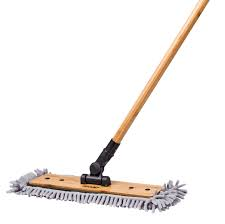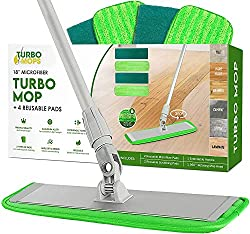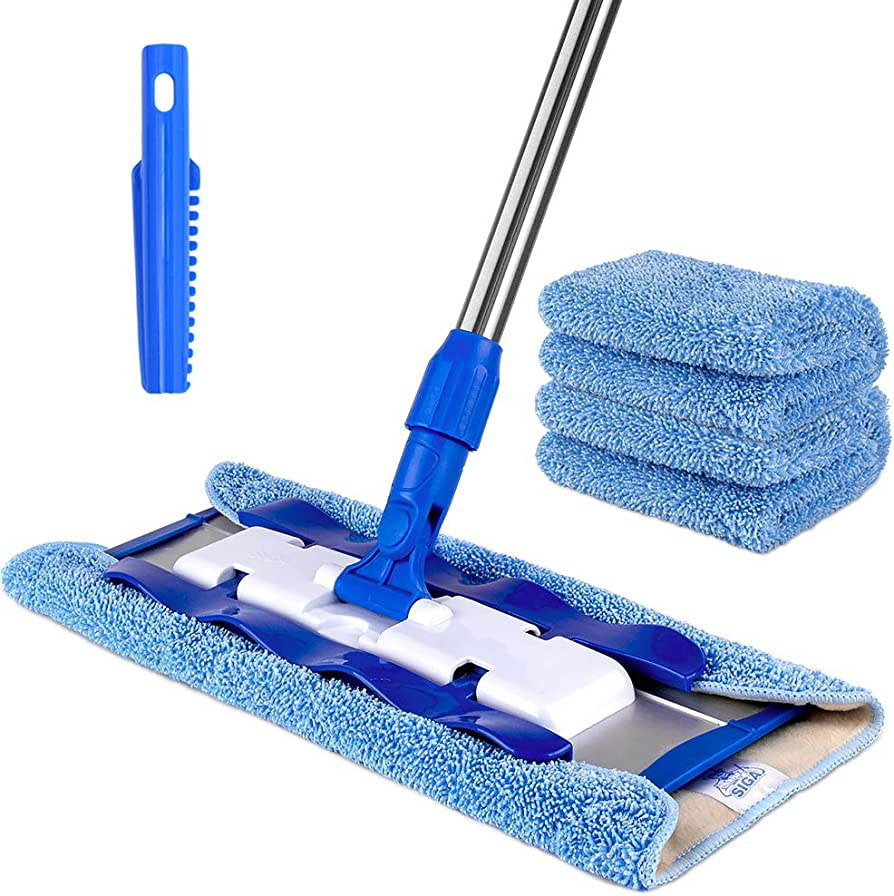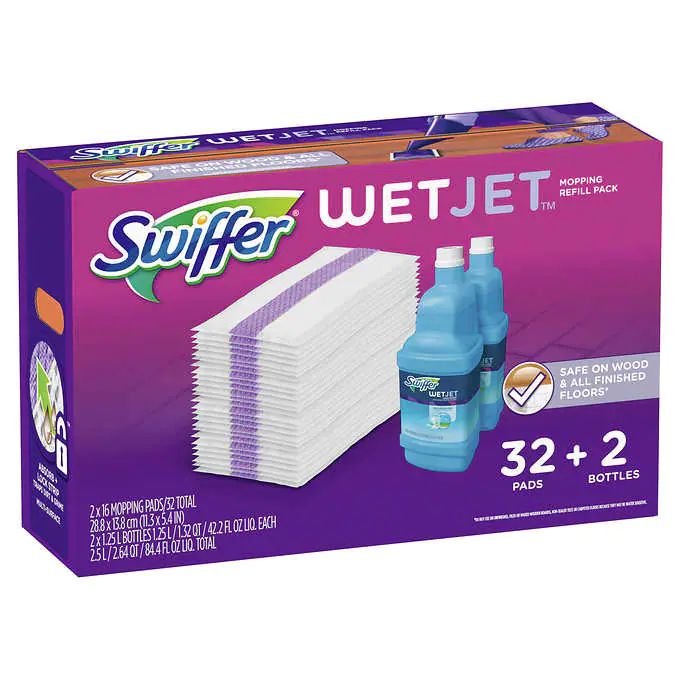
Swiffer is a popular cleaning tool that uses disposable cleaning pads. To be more sustainable, a reusable alternative to Swiffer would be a microfiber mop.
Here are a few examples:
- O-Cedar Microfiber SpinEasyWring Microfiber Spin Mop” target=”_blank” rel=”noreferrer noopener nofollow”>Mop: This mop features a hands-free wringer bucket and a high-quality microfiber mop head.
- Bona Stone, Tile & Laminate Floor Cleaner: This mop features a microfiber mop head that can be easily washed and reused.
- Bissell Spinwave Powered Hardwood Floor Mop: This mop features a spinning head and reusable microfiber pads for effective cleaning.
Swiffer alternatives
Swiffer alternatives is a well-known cleaning brand that offers a variety of floor-cleaning products. There are, however, many environmentally friendly alternatives to Swiffer for those seeking more sustainable options. The microfiber mop, for example, can be washed and reused multiple times, reducing the need for disposable cleaning pads. The traditional mop and bucket method is another Swiffer alternative that allows the user to control the cleaning solution used on their floors.
A steam mop is another option that uses heat to clean and sanitize floors without the use of harsh chemicals. Biodegradable and compostable cleaning pads are available as Swiffer alternatives for those who prefer disposable options. These options provide a variety of options for those looking to reduce their environmental impact while keeping their floors clean.
What is a Turbo Microfiber Mop
The turbo microfiber mop is a popular alternative to traditional cleaning methods such as Swiffer. It’s a highly effective cleaning tool that utilizes microfiber technology to clean floors without the use of harsh chemicals. The turbo microfiber mop is known for its efficiency, as it can clean floors quickly and effectively with just water. The mop head is also machine washable, making it a more sustainable and environmentally-friendly option compared to disposable cleaning mop heads. Additionally, the turbo microfiber mop is versatile and can be used on a variety of floor surfaces, including hardwood, tile, and laminate. In conclusion, the turbo microfiber mop is a practical and efficient choice for those looking for a more sustainable alternative to traditional cleaning methods.

11 Best Eco-Friendly Cleaning Products For A Safe Non-Toxic Home
Eco-friendly cleaning products are a great way to keep your home clean and healthy while minimizing your impact on the environment. They are often made from natural, non-toxic ingredients and are free from harmful chemicals like chlorine, phosphates, and synthetic fragrances. Here are 11 of the best eco-friendly cleaning products for a safe, non-toxic home:
- Method All-Purpose Cleaner: This plant-based cleaner comes in a variety of scents and is safe for use on all surfaces.
- Seventh Generation Dish Liquid: This biodegradable dish soap is made from plant-based ingredients and is free from synthetic fragrances and dyes.
- Mrs. Meyer’s Clean Day Multi-Surface Cleaner: This cleaner is made from natural ingredients like lemon verbena and is safe for use on all surfaces.
- Ecover All-Purpose Cleaner: This plant-based cleaner is free from phosphates and synthetic fragrances and is safe for use on all surfaces.
- Dr. Bronner’s Sal Suds: This all-purpose cleaner is made from plant-based ingredients and is free from synthetic fragrances and preservatives.
- ECOS Laundry Detergent: This plant-based laundry detergent is free from phosphates, dyes, and synthetic fragrances.
- J.R. Watkins All-Purpose Cleaner: This cleaner is made from natural ingredients and is free from synthetic fragrances and dyes.
- Better Life All-Purpose Cleaner: This plant-based cleaner is free from synthetic fragrances and dyes and is safe for use on all surfaces.
- Murchison-Hume Fantastic Spray: This all-purpose cleaner is made from plant-based ingredients and is free from synthetic fragrances and dyes.
- Bon Ami Powder Cleanser: This abrasive cleaner is made from natural ingredients and is free from synthetic fragrances and dyes.
- Norwex Microfiber Cloths: These reusable cloths can be used to clean surfaces without the need for paper towels or other disposable cleaning products.
Are sustainable alternatives to Swiffer just as effective?
Yes, many environmentally friendly alternatives to Swiffer are as effective, if not more so, at cleaning floors and surfaces. Reusable microfiber cloths, for example, are well-known for their ability to trap dirt and debris, and washable mops can be used with a wide range of cleaning solutions for a thorough clean. Furthermore, traditional broom and dustpan sets have been used for generations as a tried-and-true cleaning method.
Depending on the alternative cleaning solution used and the cleaning task at hand, it can be just as effective as the original product.
However, it may require more effort to clean and maintain than disposable cleaning pads because the microfiber pads must be washed after each use.
In any case, it’s a good idea to do some research and compare various sustainable alternatives to determine which one is best for your specific cleaning solution needs. You can help reduce waste and create a more eco-friendly home.
Are there any environmentally friendly alternatives to Swiffer?
Yes, there are several environmentally friendly alternatives to Swiffer available. Here are a few examples:
- Microfiber mops: use washable, reusable pads to clean floors, reducing waste and saving money in the long run.
- Reusable cleaning cloths: Reusable cloths made from materials like cotton or microfiber can be used to clean floors and other surfaces, reducing the need for disposable cleaning products.
- Mop with a washable head: A mop with a washable head can be used over and over again, reducing waste and saving money in the long run.
- Dry mop: A dry mop can be used to sweep up dust and debris, reducing the need for disposable cleaning products.
By choosing one of these environmentally friendly alternatives to Swiffer, you can help reduce waste and create a more sustainable home.
Is microfiber mop pads good for mapping?
Yes, microfiber mop pads can be good for mopping. Microfiber is a type of synthetic material that is known for its absorbency and ability to trap dirt and grime. When used as a mop pad, microfiber can effectively clean up wet messes and spills, leaving your floors looking clean and streak-free.
Microfiber mop pads are also very durable and long-lasting, which means that you won’t have to replace them as often as you would with disposable cleaning pads. Additionally, many microfiber mop pads can be machine washed, making it easy to keep them fresh and clean for multiple uses.

What are the disadvantages of a steam mop?
While steam mops have many benefits, there are also some disadvantages to consider:
- Cost: Steam mops can be more expensive than traditional mops and cleaning products. This may not be a cost-effective option for everyone, especially if you have a large area to clean.
- Limited use: Steam mops are typically designed for use on hard flooring surfaces such as tile, hardwood, and laminate. They may not be effective on carpets or other porous surfaces.
- Drying time: After cleaning with a steam mop, the floor may need time to dry. This can be inconvenient, especially if you need to walk on the floor or put furniture back in place.
- Maintenance: Steam mops require regular maintenance to keep them working properly, such as filling the water tank and cleaning the mop head.
- Risk of damage: If the steam mop is not used correctly, it can damage some flooring surfaces, particularly those with a delicate finish. It’s important to follow the manufacturer’s instructions and test the mop on a small, inconspicuous area first.
- Limited cleaning power: Although they are effective at removing dirt and grime, they may not be as effective at removing tough stains or heavy soil buildup. You may need to use additional cleaning products in these cases.
- Water usage: The steam mop uses a lot of water, which can be wasteful and potentially damaging if used in areas with hard water deposits.
What is Swiffer WetJet pads?
Swiffer WetJet pads are disposable cleaning pads used with the Swiffer WetJet floor cleaning system. The pads are pre-moistened with a cleaning solution and are designed to effectively clean and mop hard floor surfaces.
If you’re looking for a more sustainable alternative, there are several options available, including reusable cleaning cloths, mops with washable heads, and dry mops. By choosing one of these alternatives, you can help reduce waste and create a more environmentally friendly home.

What are the sustainable alternatives to Swiffer WetJet pads?
There are several sustainable alternatives to Swiffer WetJet pads that can help reduce waste and create a more environmentally friendly home. Here are a few examples:
- Reusable cleaning cloths: Reusable cloths made from materials like cotton or microfiber can be used to clean floors and other surfaces, reducing the need for disposable cleaning products.
- Mop with a washable head: A mop with a washable head can be used over and over again, reducing waste and saving money in the long run. You can dampen the mop with a cleaning solution or water, depending on your cleaning needs.
- Microfiber mops: It uses washable, to clean floors, reducing waste and saving money in the long run. You can dampen the mop with a cleaning solution or water, depending on your cleaning needs.
- Dry mop: A dry mop can be used to sweep up dust and debris, reducing the need for disposable cleaning products.
By choosing one of these sustainable alternatives, you can help reduce waste, save money, and create a more environmentally friendly home.
8 Best Eco-Friendly Swiffer Alternatives for Zero Waste Mopping
Eco-friendly Swiffer alternatives are becoming increasingly popular among those who are looking for more sustainable and environmentally-friendly options for cleaning their floors. One such alternative is the microfiber mop, which can be washed and reused multiple times, reducing the need for disposable cleaning pads. Another option is a traditional mop and bucket, which allows the user to control the cleaning solution used on their floors.
Additionally, there are biodegradable and compostable cleaning pads available, made from sustainable materials, as an eco-friendly alternative to Swiffer’s disposable cleaning pads. These alternatives offer a range of choices for those who want to reduce their environmental impact while keeping their floors clean. It’s important to note that using eco-friendly cleaning products and methods, like these Swiffer alternatives, can help reduce the amount of waste in landfills and decrease the use of harsh chemicals in our homes.
Here are 8 eco-friendly alternatives to Swiffer for zero waste mopping:
cedar” target=”_blank” rel=”noreferrer noopener nofollow sponsored”>O-Cedar EasyWring Microfiber Spin Mop: This mop also uses reusable microfiber pads, and has a built-in wringer to help keep hands dry while wringing out the mop.
leifheit” target=”_blank” rel=”noreferrer noopener nofollow sponsored”>Leifheit Professional Microfiber Mop: This mop has a telescoping handle and a machine-washable microfiber pad, making it versatile.
simple mop” target=”_blank” rel=”noreferrer noopener nofollow sponsored”>Real Simple Clean Microfiber Spray Mop: The Real Simple Clean Microfiber Spray Mop is a convenient and effective cleaning tool for floor cleaning. It features a microfiber mop head that is designed to effectively clean floors and a spray bottle that allows you to apply the cleaning solution directly onto the floor. The microfiber mop head is machine washable, making it a more sustainable alternative to disposable cleaning pads.
The spray bottle design of the Real Simple Clean Microfiber Spray Mop allows for a more controlled cleaning experience, as you can choose the amount of cleaning solution to be used. Additionally, the mop’s lightweight design makes it easy to maneuver and use on various floor surfaces, including hardwood, tile, and laminate. In conclusion, the Real Simple Clean Microfiber Spray Mop, with its convenient spray bottle design, is a practical and efficient choice for those looking for a sustainable and effective floor-cleaning solution.
18inchmops” target=”_blank” rel=”noreferrer noopener nofollow sponsored”>18″ Microfiber Flat Mop: This mop has a simple, flat design and a reusable microfiber pad, making it a no-fuss option for eco-friendly mopping.
These are just a few of the many eco-friendly alternatives to Swiffer that are available on the market. By choosing one of these options, you can reduce your household waste while still keeping your floors clean and shiny.
what are Swiffer pads?
Swiffer pads are disposable cleaning pads that are used with Swiffer brand cleaning products, such as the Swiffer Sweeper and Swiffer Duster. The pads are designed to be used to clean floors, dust surfaces, and pick up pet hair, among other uses.
Swiffer pads are made of a combination of materials, including synthetic fibers and a low-tack adhesive, that allow them to effectively trap and hold dirt, dust, and other particles. The pads are designed to be used with a Swiffer handle and can be easily removed and replaced when they become dirty.
Swiffer sweeper is popular because of their ease of use and convenience, but they are not environmentally friendly because they are disposable and contribute to the problem of plastic waste.
Swiffer Sweeper Dry and Wet
Swiffer Sweeper is a cleaning tool that is designed to make cleaning your floors easier and more convenient. It consists of a handle and a reusable or disposable cleaning pad that can be used to clean both dry and wet messes. The Swiffer Sweeper Dry sweeping pad is designed to pick up dirt, dust, and pet hair, while the Swiffer Sweeper Wet mopping pad is designed to clean up wet messes, like spills and mud.
The pads can be easily attached to and removed from the handle, making it simple to switch between dry and wet cleaning tasks. The Swiffer Sweeper is a versatile tool that can be used to clean a variety of flooring surfaces, including hardwood, tile, and linoleum.
One of the main benefits of the Swiffer Sweeper is that it’s a low-maintenance tool. The disposable cleaning pads can be easily replaced when they become dirty, reducing the need for frequent washing. The reusable cleaning pads can also be machine washed, making it easy to keep them fresh and clean for multiple uses.
Another advantage of the Swiffer Sweeper is that it’s a relatively inexpensive cleaning tool, making it an accessible option for many households. Additionally, the Swiffer Sweeper is available in a variety of different models and styles, so you can choose the one that best fits your cleaning needs and preferences.
Can Swiffer pads be composted?
No, It cannot be composted. These are made of a combination of materials, including synthetic fibers, plastic, and adhesives, that are not suitable for composting. Composting is a process of breaking down organic matter into a nutrient-rich soil amendment, and it requires materials that are primarily composed of organic matter, such as food scraps and yard waste.
The synthetic fibers and plastic materials in Swiffer pads do not break down in a compost pile and will remain in the environment for a long time, contributing to the problem of plastic pollution.
If you are looking for an environmentally friendly way to clean your floors and surfaces, you may consider using a broom” target=”_blank” rel=”noreferrer noopener nofollow sponsored”>broom or using a product with What are the most eco-friendly wet wipes?
Reusable cloth wipes: Cloth wipes can be made from a variety of materials, such as cotton, hemp, or bamboo, and can be washed and reused multiple times. This makes them a sustainable and zero-waste alternative to disposable wet wipes. Biodegradable wet wipes: Biodegradable wet wipes are made from materials that break down naturally over time, reducing their impact on the environment. Some popular biodegradable options include wipes made from bamboo, wood pulp, or plant-based materials. Compostable wet wipes: Compostable wet wipes are made from materials that can be composted, breaking down into nutrient-rich soil. These wipes are often made from natural fibers such as cotton or bamboo and can be composted in a home compost bin or with yard waste. Eco-friendly disposable wipes: There are also disposable wipes made from sustainable materials, such as those made from recycled paper or biodegradable materials. These wipes can be a good option for those who prefer the convenience of disposable wipes but want to reduce their impact on the environment. It’s important to note that not all products labeled as “eco-friendly” or “biodegradable” are actually environmentally friendly, so it’s a good idea to carefully read the product label and do some research to determine which products are truly sustainable and biodegradable. Swiffer cloths are typically made from a combination of synthetic fibers and a low-tack adhesive material. The synthetic fibers are used to trap and hold dirt, dust, and other particles, while the low-tack adhesive allows the cloth to effectively clean without leaving residue behind. Swiffer cloths are designed to be used with a Swiffer handle and are meant to be disposable, which means they are not considered to be an environmentally friendly option. Once they are used and disposed of, they contribute to the problem of plastic waste. If you are looking for a more sustainable option, you may consider using reusable cloths made from natural fibers, such as cotton or bamboo, or using a mop and a cleaning solution. These options can help reduce waste and support sustainable practices. The system uses specially designed pads that are made to fit the device. The official is available in various versions, including multi-surface, wood floor, and heavy-duty. If you are looking for more environmentally friendly options. These pads can be made from materials such as microfiber or terry cloth and can be washed and reused multiple times. This can help reduce waste and minimize your environmental impact. Yes, you can use it. It can be made from materials such as microfiber or terry cloth and is designed to be used with the device in place of disposable pads. It can help reduce waste and minimize your environmental impact, as you can wash and reuse the pads instead of throwing them away after each use. Store the pads in an airtight container: Keeping the pads in an airtight container can help prevent them from drying out. You can use a plastic bag or container with a tight-fitting lid. Keep the pads away from direct sunlight: Direct sunlight can cause the pads to dry out quickly, so it’s best to store them in a cool, dry place that is out of direct sunlight. Use a damp cloth to cover the pads: If you are storing the pads for a short period of time, you can use a damp cloth to cover the pads and help keep them moist. Use the pads before they dry out: The best way to prevent the pads from drying out is to use them before they have a chance to. Make sure to keep a close eye on the pads and use them before they start to dry out. Store the pads in the solution: If you have a spare container of the solution that the pads are designed to be used with, you can store the pads in the solution until you are ready to use them. This will help keep the pads moist and ready to use. Yes, some Swiffer pads can be washed and reused. There are available that are specifically designed to be used with the Swiffer, and they can be washed and reused several times before needing to be replaced. Reusable Swiffer pads are often made of materials such as microfiber or terry cloth, and they can be attached to the bottom of the Swiffer in the same way that disposable pads are. When the pads become dirty, they can be removed, washed, and used again. The frequency with which you should change your Swiffer pad will depend on several factors, including the type of pad you are using, the amount of dirt and grime it has been exposed to, and the frequency and intensity of use. The number of times a Swiffer pad can be reused will depend on several factors, including the type of material used for the pad, the amount of dirt and grime it has been exposed to, and the frequency and intensity of use. In general, it can be washed and used several times before they need to be replaced. Some users report that they are able to reuse their pads as many as 50 times or more, while others find that they need to replace their pads after 10 to 20 uses. It’s important to wash them regularly and store them in a clean, dry place. Avoid exposing the pads to harsh chemicals or high heat, as this can cause them to deteriorate more quickly. Reusable cloth wipes: These are wipes made from materials such as cotton, bamboo, or hemp, which can be washed and reused multiple times. Reusable cloth wipes are a zero-waste option and do not contribute to the problem of plastic pollution. Biodegradable wipes: These are wipes made from materials that will break down naturally over time, such as bamboo or plant-based materials. Biodegradable wipes are a more environmentally friendly option than traditional disposable wipes, but they are not completely compostable and may take longer to break down than other materials. Compostable wipes: Compostable wipes are made from materials that can be composted, breaking down into nutrient-rich soil. These wipes are often made from natural fibers such as cotton or bamboo and can be composted in a home compost bin or with yard waste. Yes, there are commercially available biodegradable wet wipes. Wet wipes made of biodegradable materials, like bamboo or plant-based materials, decompose naturally over time. Compared to conventional disposable wipes, which are typically made of non-biodegradable plastic and can take hundreds of years to decompose in the environment, these wipes are a more environmentally friendly option. Bamboo wipes can be considered environmentally friendly to a certain extent. Bamboo is a highly renewable resource that grows quickly and does not require the use of pesticides or fertilizers, making it a sustainable material for products such as wipes. The decomposition time for bamboo wipes depends on several factors, such as the conditions in which they are disposed of (e.g., temperature, moisture), the type of material used in the wipes, and the presence of other organic matter in the environment. In general, bamboo wipes can take several months to several years to decompose, depending on the conditions. Bamboo is a biodegradable material, which means that it will break down naturally over time, but it still takes time for the process to occur. The answer to this question is subjective and depends on individual preferences and needs. Here are a few factors to consider when comparing a Swiffer to a mop: Convenience: Swiffers are often seen as being more convenient than traditional mops, as they are quicker and easier to use and don’t require as much storage space. Additionally, disposable Swiffer pads can be more hygienic than reusable mop pad heads. Cleaning efficiency: Some people find that Swiffers are more effective at picking up dirt and debris compared to traditional mops, as the electrostatic charge of the Swiffer pads helps to attract dirt. However, others argue that mops are better at deep cleaning, as they can hold more water and cleaner solution. Environmental impact: Traditional mops, particularly those made from natural fibers, are often seen as being more environmentally friendly than Swiffers.Here are some of the most eco-friendly wet wipes:
What are Swiffer clothes made out of?
What pads work with Swiffer Wet Jet?
Can you use reusable pads on Swiffer Wet Jet?
How do you keep Swiffer wet pads from drying out
Here are some tips to help keep Swiffer wet pads from drying out:
Can Swiffer pads be washed and reused?
How often should I change my Swiffer pad?
How many times can you reuse a Swiffer pad?
Are there any environmentally safe wipes?
There are several types of wipes that are considered to be environmentally friendly:
Are there biodegradable wet wipes?
Are bamboo wipes environmentally friendly?
How long do bamboo wipes take to decompose?
Is a Swiffer really better than a mop?
Leave a Reply